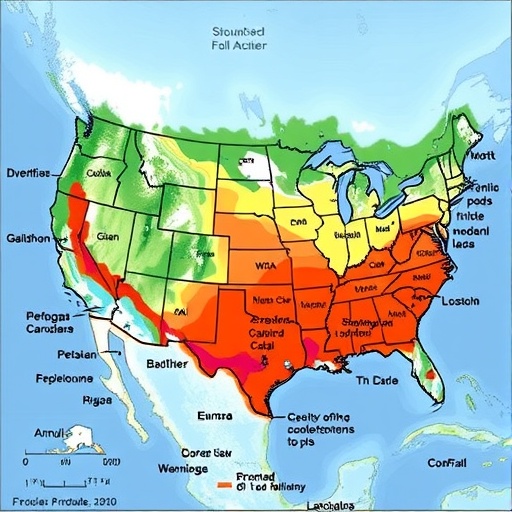The arid landscapes of the American Southwest have long posed a challenge to researchers aiming to unravel the complexities of regional climate variability. A groundbreaking new study, recently published in Nature Communications, sheds unprecedented light on the hydroclimate dynamics of this region, spanning an astonishing temporal scale—six full glacial-interglacial cycles. This scientific breakthrough offers crucial insights into past climate fluctuations and sets the stage for improved predictions of future water availability in one of the most drought-prone areas on the planet.
In the study led by Wendt, Carolin, Buizert, and their colleagues, a sophisticated analysis was performed to decipher the controls governing hydroclimatic shifts in the southwestern United States. By leveraging a multi-proxy approach combined with advanced climate modeling techniques, the team successfully reconstructed hydroclimate variability over approximately 600,000 years. This extensive timeframe encompasses multiple transitions between ice age and warmer interglacial periods, enabling an exploration of how external and internal climate forcings have modulated the region’s moisture balance.
Central to the investigation was the use of speleothems—mineral deposits from cave formations—as high-resolution paleo-hydrological archives. These formations capture environmental signals in their isotopic and chemical signatures, which can be precisely dated and analyzed to infer past precipitation patterns and climatic conditions. The research team meticulously sampled and characterized speleothem records across several cave sites in the southwest, providing a continuous chronological framework of hydroclimate variability.
Coupling these empirical data with state-of-the-art climate models, the study delves into the intricate interplay between large-scale atmospheric circulation patterns and local hydrological responses. The scientists identified key drivers such as shifts in the Pacific Ocean’s sea surface temperatures, the position and strength of the jet stream, and variations in monsoonal moisture delivery—all of which orchestrate the region’s precipitation regimes. These dynamic processes collectively dictated periods of aridity and pluvial conditions throughout the glacial-interglacial cycles.
A particularly striking aspect of the findings is the differentiated response of the southwest USA hydroclimate to glacial versus interglacial states. During glacial maxima, the study reveals recurring episodes of intensified aridity, attributed to a poleward displacement of storm tracks and weakened monsoonal activity. Conversely, interglacial intervals exhibit enhanced moisture influx linked to warmer sea surface temperatures and more pronounced monsoon circulation. This dichotomy not only conforms to theoretical climate expectations but also provides empirical evidence for the sensitivity of southwestern hydroclimate to global climate boundary conditions.
Moreover, the research highlights the pivotal role of ice sheet dynamics in modulating regional atmospheric circulation. The waxing and waning of Laurentide and Cordilleran ice sheets altered pressure gradients and airflow patterns, which in turn influenced the delivery of Pacific moisture. The legacy of these long-distance teleconnections underscores the complexity of hydroclimate responses and challenges simplistic attributions based solely on local parameters.
From a methodological perspective, the application of isotope-enabled modeling frameworks allowed for a robust quantitative comparison between proxy data and simulated climate variables. This integration is crucial in disentangling the relative contributions of temperature, precipitation source changes, and evaporation effects to the isotopic records preserved in speleothems. Such comprehensive analytical rigor enhances the confidence in interpreting paleoclimate archives and advances the broader field of climate reconstructions.
Importantly, this research has profound implications for understanding future water resource risks in the southwestern United States. By elucidating the natural range and drivers of hydroclimate variability over multiple glacial cycles, the study establishes a benchmark against which anthropogenic influences can be gauged. The documented sensitivity of the region’s moisture availability to oceanic and atmospheric forcings suggests that ongoing climate change could exacerbate drought frequency and intensity, posing significant challenges for ecosystems and human societies alike.
The multi-millennial perspective also sheds light on the potential for abrupt hydroclimate transitions, which are often difficult to predict using contemporary observational records alone. Such regime shifts could arise from nonlinear responses within the climate system, triggered by relatively minor perturbations in forcing variables. Understanding these thresholds is critical for developing adaptive management strategies and enhancing resilience to climatic extremes.
Beyond its immediate regional focus, this study contributes important knowledge to the broader scientific quest to comprehend the mechanisms driving hydroclimate variability across the globe. The southwest USA, as a climatologically sensitive and data-rich region, serves as an exemplary case study for exploring how interconnected climatic subsystems respond to natural forcing over geological timescales. The approach and findings from this research will undoubtedly inform similar studies in other vulnerable parts of the world.
In terms of environmental policy and practical applications, the insights garnered could guide water management and conservation efforts. Recognizing historical patterns and their governing controls assists in anticipating future scenarios under climate change. For policymakers, integrating such paleoclimatic understanding with socioeconomic planning may secure more sustainable water use in an increasingly uncertain future characterized by volatility and scarcity.
This pioneering work also underscores the importance of continued investment in paleoclimate research, combined with innovations in geochemical analysis and climate modeling. The synthesis of high-fidelity proxy datasets with predictive computational tools represents the frontier of climate science, enabling breakthroughs that were previously unattainable. The study by Wendt and colleagues exemplifies how interdisciplinary collaboration spawns transformative discoveries capable of shaping our knowledge and stewardship of Earth’s natural systems.
To conclude, the revelation of controls on southwest USA hydroclimate over six glacial-interglacial cycles marks a significant milestone in climatology. The paper’s blend of empirical data and model simulations not only reconstructs a detailed history of regional hydrological shifts but also provides a roadmap for anticipating future changes amid global warming. The stakes are high for a region where water is life, and this research lays the scientific foundation on which sustainable strategies and adaptive resilience can be built.
Subject of Research: Controls on southwest USA hydroclimate variability over the past six glacial-interglacial cycles.
Article Title: Controls on the southwest USA hydroclimate over the last six glacial-interglacial cycles.
Article References:
Wendt, K.A., Carolin, S., Buizert, C., et al. Controls on the southwest USA hydroclimate over the last six glacial-interglacial cycles. Nat Commun 16, 10007 (2025). https://doi.org/10.1038/s41467-025-64963-1
Image Credits: AI Generated




